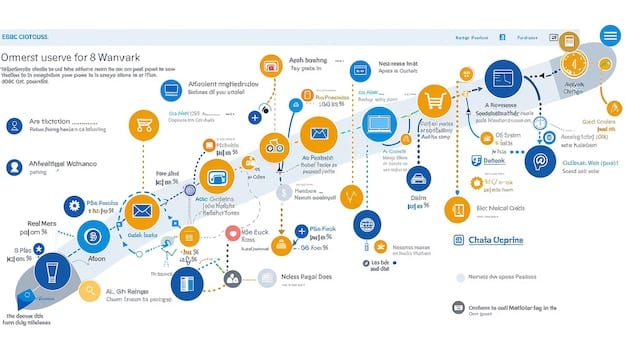Maximize Customer Satisfaction: The Importance of Omnichannel Customer Experience

The importance of omnichannel customer experience lies in its ability to create a unified and seamless journey for customers across all interaction points, enhancing satisfaction and loyalty. This strategy ensures customers receive consistent and personalized support, regardless of the channel they choose.
In today’s hyper-connected world, customers expect seamless and consistent experiences across all channels. Understanding the importance of omnichannel customer experience is no longer a luxury, but a necessity for businesses aiming to thrive. But what does it truly mean to create a seamless customer journey across all touchpoints?
This article delves into the core strategies and benefits of implementing an effective omnichannel approach, ensuring your customers feel valued and understood at every interaction. By strategically integrating various channels, businesses can foster stronger customer relationships and drive long-term growth.
Understanding the Essence of Omnichannel Customer Experience
At its heart, omnichannel customer experience is about providing a consistent and integrated brand experience to customers across all available channels and devices. Unlike multichannel, which simply offers multiple channels, omnichannel focuses on creating a seamless, unified interaction.
Defining Omnichannel vs. Multichannel
Many businesses confuse omnichannel with multichannel. Multichannel involves operating across various channels, such as email, phone, and social media, but these channels often function in silos. Omnichannel, on the other hand, integrates these channels so that interactions flow smoothly from one to another.
- Data Integration: Omnichannel leverages unified data to personalize interactions.
- Seamless Transitions: Customers can switch between channels without repeating information.
- Consistent Messaging: Ensures a consistent brand voice and message across all touchpoints.
For instance, a customer might browse a product on a mobile app, add it to their cart, and then complete the purchase later on a desktop computer. The importance of omnichannel customer experience is evident here, as the customer’s shopping cart and preferences are seamlessly transferred between devices.

Why The Importance of Omnichannel Customer Experience Matters
The importance of omnichannel customer experience extends beyond just convenience. It fundamentally impacts customer satisfaction, loyalty, and, ultimately, your bottom line. By creating a cohesive customer journey, businesses can cultivate stronger relationships and lasting connections.
Enhanced Customer Satisfaction
When customers have a smooth and consistent experience, their satisfaction levels soar. Omnichannel strategies cater to their preferences, making it easier for them to interact with your business on their terms. This personalized approach breeds positive associations.
For example, consider a customer who initiates a support query via live chat on your website. If that issue isn’t resolved immediately and they decide to call your customer service line later, an omnichannel system ensures the agent has access to the chat transcript. This saves the customer from repeating themselves, thus enhancing their experience.
Increased Customer Loyalty
Loyalty is earned through consistently positive experiences. An omnichannel approach demonstrates that you value your customers’ time and preferences, leading to greater brand loyalty. Loyal customers are more likely to make repeat purchases and recommend your brand to others.
- Personalized Offers: Tailor promotions based on past interactions across all channels.
- Proactive Support: Anticipate customer needs based on their journey.
- Loyalty Programs: Integrate rewards across all touchpoints.
In essence, the importance of omnichannel customer experience lies in its ability to make customers feel understood and valued, fostering long-term relationships.
Strategies for Creating a Seamless Omnichannel Journey
Creating a seamless omnichannel journey requires careful planning and execution. It involves aligning your technology, processes, and teams to deliver consistent experiences across all touchpoints. Here are actionable strategies to get started.
Mapping the Customer Journey
Start by mapping out the various touchpoints your customers interact with, from initial awareness to post-purchase support. Identify pain points and opportunities for improvement at each stage. Customer journey maps provide invaluable insights into their needs and expectations.
Integrating Technology Platforms
A robust tech stack is crucial for gathering and synthesizing customer data from disparate sources. Customer Relationship Management (CRM) systems play a pivotal role, consolidating interactions for a unified view of each customer. Ensure your CRM is integrated with other platforms like email marketing, chatbots, and e-commerce systems.
- CRM Integration: Centralize customer data for personalized interactions.
- API Connectivity: Use APIs to facilitate seamless data flow between systems.
- Cloud-Based Solutions: Opt for scalable and accessible platforms.
Leveraging unified data allows businesses to personalize interactions. The importance of omnichannel customer experience becomes clear when technology bridges the gaps between channels, providing a holistic view of the customer.

Leveraging Data for Personalized Experiences
Data is the lifeblood of any successful omnichannel strategy. By collecting and analyzing customer data from various touchpoints, businesses can deliver personalized experiences that resonate with their audience. This not only enhances engagement but also drives conversions.
Data Collection and Analysis
Implementing robust data collection mechanisms is essential. This includes tracking website behavior, purchase history, social media engagement, and customer service interactions. Use analytics tools to identify patterns and glean actionable insights from this data.
With analytics tools and consolidated information, you can identify patterns to improve the overall Customer Experience.
Personalization Techniques
Personalization goes beyond addressing customers by their name. It involves tailoring content, offers, and recommendations based on their preferences and past behavior. This level of customization demonstrates that you understand their needs and are committed to delivering value.
- Personalized Content: Serve up relevant articles, videos, and product recommendations.
- Targeted Offers: Provide exclusive discounts and promotions based on past purchases.
- Behavioral Triggers: Send automated emails or messages based on specific actions.
Ultimately, data-driven personalization underscores the importance of omnichannel customer experience, transforming generic interactions into meaningful engagements.
Measuring the Success of Your Omnichannel Strategy
Implementing an omnichannel strategy is an ongoing process that requires continuous monitoring and optimization. Measuring your success involves tracking key performance indicators (KPIs) and making data-driven adjustments to improve the customer journey.
Key Performance Indicators (KPIs)
Several KPIs can help you evaluate the effectiveness of your omnichannel strategy. These include customer satisfaction scores (CSAT), Net Promoter Score (NPS), customer lifetime value (CLTV), and conversion rates. Regularly track these metrics to gauge your progress.
By tracking various metrics, the importance of omnichannel customer experience can be quantified, allowing businesses to make informed decisions and refine their strategies.
Continuous Optimization
An omnichannel approach is not a one-time project. It requires a commitment to continuous optimization. Regularly review your data, gather customer feedback, and test different approaches to identify what works best for your audience. Adapt your strategy as customer needs and preferences evolve.
- A/B Testing: Experiment with different messaging and offers across channels.
- Customer Feedback: Actively solicit input through surveys and feedback forms.
- Data Analysis: Continuously monitor KPIs and identify areas for improvement.
Through continuous optimization, you reinforce the importance of omnichannel customer experience, ensuring your strategy remains effective and aligned with customer expectations.
| Key Aspect | Brief Description |
|---|---|
| 🔗 Unified Experience | Ensuring seamless transitions between platforms. |
| 📊 Data Integration | Using consolidated data for personalized interactions. |
| 🎯 Personalization | Tailoring content and offers based on customer behavior. |
Frequently Asked Questions (FAQs)
Omnichannel customer experience involves providing a seamless, integrated experience across all interaction channels. The importance of omnichannel customer experience lies in enhancing satisfaction and fostering long-term loyalty.
Multichannel marketing uses multiple channels independently, while omnichannel integrates these channels. Omnichannel ensures a unified experience where customers can switch between channels seamlessly.
Key strategies include mapping the customer journey, integrating technology platforms, and leveraging data for personalization. Each step underscores the importance of omnichannel customer experience.
Data from various touchpoints allows businesses to tailor content, offers, and recommendations based on customer preferences, making interactions more relevant and engaging.
Businesses should monitor KPIs such as customer satisfaction scores (CSAT), Net Promoter Score (NPS), and customer lifetime value (CLTV) to evaluate the effectiveness of their omnichannel efforts. These metrics highlight the importance of omnichannel customer experience.
Conclusion
In conclusion, understanding and implementing the importance of omnichannel customer experience is crucial for businesses aiming to thrive in today’s competitive landscape. By focusing on seamless integration, personalization, and continuous optimization, organizations can cultivate stronger customer relationships and drive sustainable growth.
By embracing omnichannel strategies, businesses can not only meet but exceed customer expectations, leading to increased loyalty and bottom-line success. The shift toward unified, customer-centric approaches is more than a trend—it’s a fundamental requirement for sustained competitive advantage.





